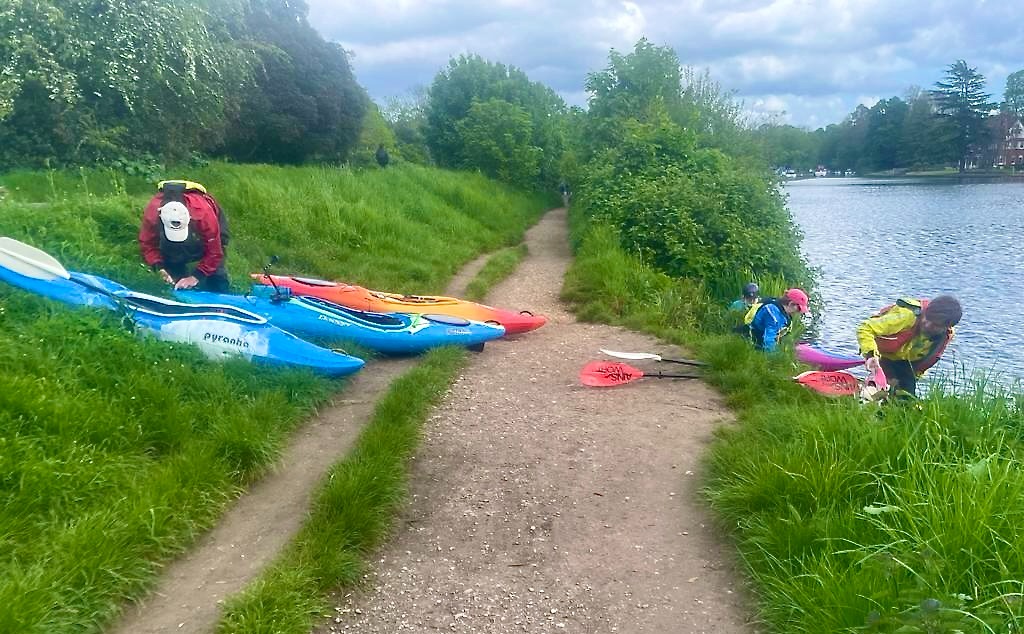The final paddle of the non-tidal section of the Thames started just outside Chertsey Lock (KT16 8LF) and ended just before Teddington Lock (TW10 7YE) on a lovely sunny day.

Our get-in was a convenient slide-in between the lock and Chertsey Bridge on the left bank of the river. There’s enough space alongside the road to unload and kit up before shuttling vehicles to the get-out.

Shepperton Lock was the first of three to negotiate and was the only one we passed through without a portage. The lock keeper had seen us coming and filled the lock ahead of our arrival, so we were soon in and out.
During the first half of the trip there were showers of “condensation”, some very heavy. This obviously wasn’t rain according to Dave because his trips only ever have tropical sunshine. We were all totally convinced about that!

Just after D’oyly Carte Island there’s a straight passage that shaves off about a mile and a half of loop in the Thames, creating Desborough Island. We took the cut and as it turned out, this was a good move because by the end of the trip we’d paddled twelve and a half miles and that extra distance would have been a stretch too far. The tree-lined cut hides the large water treatment works on the island.
Lunch stop number one was taken at Sunbury Lock. There are two locks side by side here and roller portage to one side. The rollers were partially seized so the anticipated fun of rolling down to the river didn’t materialise. Instead, there was much pushing and pulling to get Pierre and his kayak back into the water. It was easier to just slide in from the bottom of the adjacent slipway.


A few rowing enthusiasts were out on the river. Markedly faster than us of course. That included the lucky students from St Georges College (Walton on Thames), preparing to row out from their club house, under the shouty tutelage of one of their teachers.
Despite the “condensation”, it was lovely to see the trees and banksides clothed in the fresh green of spring. Such a stark contrast from the icy, misty, monochrome of winter. Amongst the greenery the urban build-up of outer London is more noticeable with many eyots, aits, islands (call them what you will) developed with homes large and small. The shores of the river are lined with traditional and super-modern properties with barge and multi-storied house boats moored up in between.
Our final lock at Molesey also has a roller portage and was similarly dysfunctional in the rolling department. These roller portages are sort of meant for the punts and skiffs that ply this section of the Thames.
Lunch stop number two was on a small beach opposite the great golden gates of Hampton Court Palace. It would have been nice to alight at the Palace jetty but that was too high to clamber onto. We admired the view from across the river and fed the ducks that miraculously appeared at the first sound of a sandwich being unwrapped.

Kingston Bridge marked the final leg of the trip with the mess of Kingston town centre’s road system hidden from view at river level. From here it was just another mile and a half to the get-out, but with the wind blowing across us, it made it seem a lot longer and some of us (especially me) were starting to fade!

Finally, a weary and grateful get-out at the bank at the edge of the park beside Burnell Avenue where we’d left our vehicles. Followed by a grass tow to the cars that also, and very handily, cleaned up the hulls. We ended the day with a debrief in The Anglers on the opposite bank just a long walk downstream from where we’d parked.

The players:
Dave Hillier, Phil, Sue, Conrad, John, Pierre,

Write up by Pierre Leon.
Paddle The Thames by Mark Rainsley – Pesda Press ISBN 9781906095598

Well done all. Chris